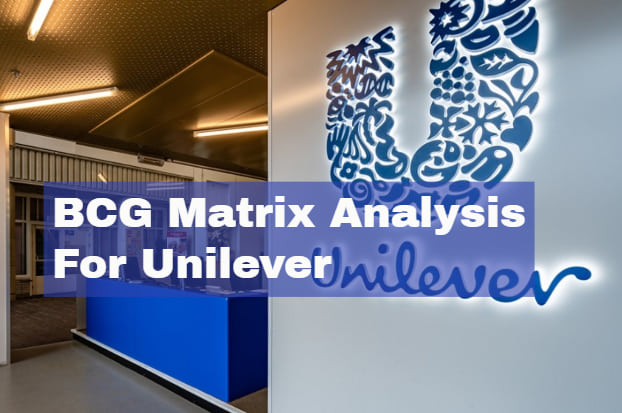In today’s competitive market, companies need to constantly evaluate their product portfolios to ensure they are delivering the right products to the right markets. One of the most popular and effective tools for portfolio analysis is the BCG Matrix.
This blog post will delve into the BCG Matrix for Unilever for evaluating their present product portfolio and making informed decisions on investing resources in the upcoming times.

Introduction to BCG Unilever’s Matrix
The BCG Matrix is a popular corporate portfolio analysis tool that helps organizations like Unilever evaluate their product portfolios based on market share and growth. Unilever, the world’s third-largest consumer goods company, has a vast range of products in different markets, making it crucial for them to prioritize and allocate resources effectively.
The BCG Matrix helps Unilever categorize each of their products or brands as cash cows, stars, question marks, or dogs. In this way, they can identify which products or brands require further investment, which can continue to generate cash, and which need to be phased out.
BCG Matrix of Unilever
In this section, we will explore Unilever’s products in these categories and how the BCG Matrix can inform their future decisions.
Stars Products of Unilever: High Market Share and High Growth
When it comes to the BCG Matrix analysis of Unilever, the Stars quadrant highlights products with high market share and high growth potential.
Unilever’s personal care segment has proven to be a star in the BCG Matrix analysis, with products like Lux, Sunsilk, and Fair & Lovely holding high market shares and showing steady growth.

As pioneers in their industry, star products not only generate significant cash flow for Unilever but also hold promising potential for the future.
By investing in these products, Unilever can maintain its market dominance and position itself for even greater success.
The BCG Matrix analysis helps Unilever identify these star products and allocate resources accordingly to maximize their potential. As Unilever continues to grow, these star products will play a critical role in its future success.
Unilever’s Cash Cows: Products with High Market Share and Slow Growth
Unilever has a number of products that fall under the Cash Cow category in the BCG Matrix analysis. These are products that may not have high growth in the market, but still maintain a high market share and generate substantial profits for the company.
For example, Marmite is a key Cash Cow for Unilever, with sales remaining steady in the spreads industry despite slow growth. Similarly, the home care and refreshment segments of Unilever can be labelled as Cash Cows because both have high market share and generate a significant amount of revenue.
Another example is HPC (Home and Personal Care), which is also a Cash Cow for Unilever. Although these products may not require a lot of investment, they still generate a substantial amount of cash for the company.
With these cash cows, Unilever can continue to invest in other product lines that require more resources to grow and expand.
Dogs Products of Unilever: Low Market Share and Slow Growth
Unilever also has products that fall under the Dogs category in the BCG Matrix analysis. These are products with low market share and slow growth, meaning they neither generate cash nor require a large amount of it.
Despite their limited potential in the market, Unilever still invests in these products as they serve as a foundation for generating revenue to be poured into other brands that lie in the star or cash cow category. These are products that may not have much potential for growth but still have a loyal consumer base.
Examples of dogs product in Unilever are the Axe deodorant, the Lipton RTD tea, and the Brylcreem men’s grooming line. Although they hold a low market share, Unilever can still benefit from these established products while continuing to innovate and invest in their star and cash cow products.
Question Marks Products of Unilever: Low Market Share and High Growth
The BCG Matrix of Unilever’s product portfolio highlights a group of products that fall under the “Question Marks” category, characterized by low market share and high growth potential. As the name suggests, these products are still uncertain in terms of future potential due to their low market share. However, since the growth rate is high, they can become stars with effective marketing strategies.
Unilever’s food segment is a perfect example of this category. These products require significant investment to increase their market share, but if Unilever can successfully capitalize on their potential, they can become profitable segments in the long term.
Implications for Unilever’s future
The BCG Matrix analysis of Unilever has provided valuable insight into the company’s portfolio management. With its stars, cash cows, dogs, and question marks products identified, Unilever can make informed decisions on where to allocate extra resources and marketing efforts.
It is clear that Unilever’s future success hinges on its ability to develop and promote its question marks products. These products have low market share but high growth potential, making them the future stars of Unilever’s portfolio. By strategically investing in these products, Unilever can achieve sustained growth and stay ahead of the competition.
The implications of the BCG Matrix analysis for Unilever’s future are clear – invest in the right products and you will reap the rewards. Unilever must continue to review its portfolio regularly to ensure it remains relevant and competitive in an ever-changing market.
Importance of BCG Matrix for Portfolio Management
The BCG Matrix is an essential tool for portfolio managers, as it helps them review their brands and products across industries and SBUs.
For Unilever, the BCG Matrix analysis can be used to identify its stars (high-growth, high-market-share products), cash cows (high-market-share, slow-growth products), dogs (low-market-share, slow-growth products), and question marks (low-market-share, high-growth products).
By identifying these categories, Unilever can better allocate its resources and make strategic decisions for its future. The BCG Matrix can provide a graphic representation for the organization to examine different businesses in its portfolio management and value investing.
Therefore, using the BCG Matrix can be valuable for Unilever to strategically plan and manage its diverse businesses.
Final Thought
In conclusion, the BCG Matrix has proven to be a valuable tool for portfolio managers to assess their brand and product portfolio. For Unilever, the analysis has revealed that they have a strong brand portfolio with products that fall into each of the four categories of the matrix.
By utilizing the BCG Matrix, Unilever can make informed decisions on which products to invest in, maintain, or divest, ensuring a successful and profitable future for the company.
Disclosure: The articles, guides and reviews on BlowSEO covering topics like SEO, digital marketing, technology, business, finance, streaming sites, travel and more are created by experienced professionals, marketers, developers and finance experts. Our goal is to provide helpful, in-depth, and well-researched content to our readers. You can learn more about our writers and the process we follow to create quality content by visiting our About Us and Content Creation Methodology pages.
